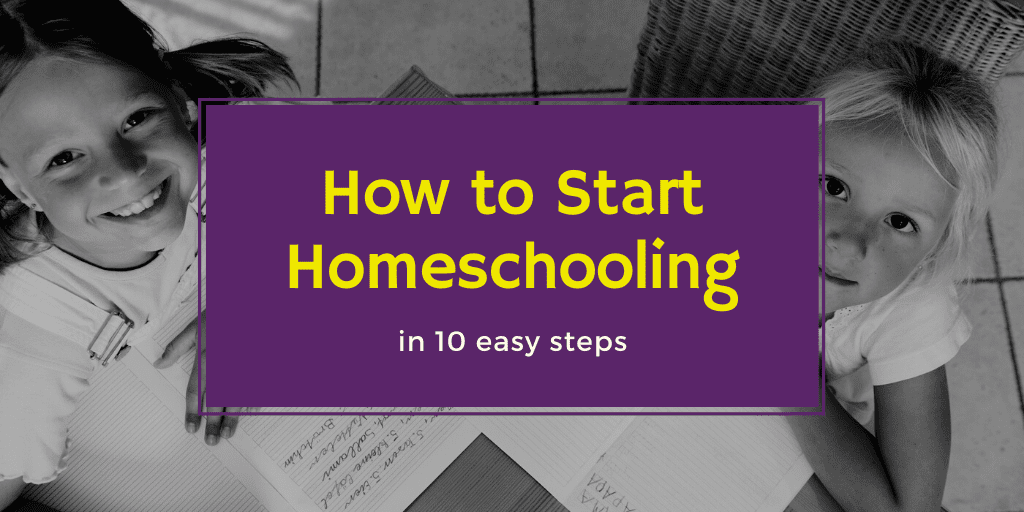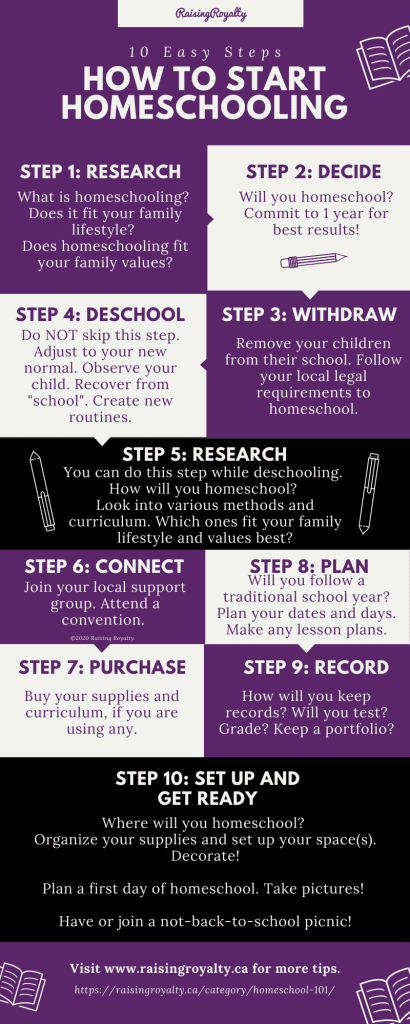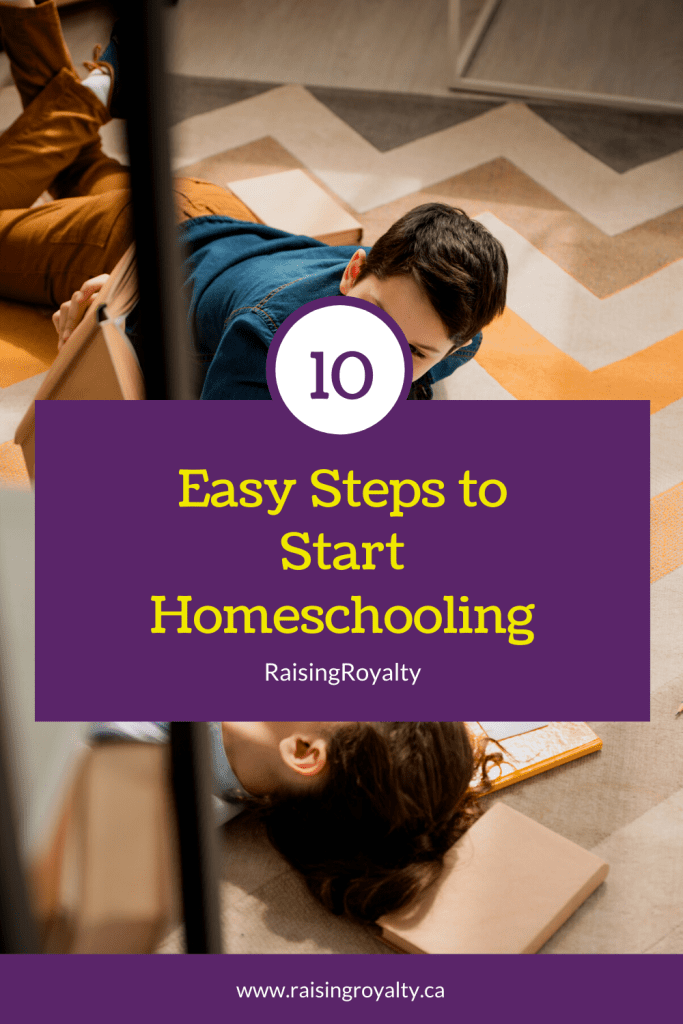

When you first consider homeschooling, it can seem overwhelming. Where do you start? What curriculum should you get? Does the school give you curriculum? How long does it take? And soo many more questions! Just figuring out how to start homeschooling can be scary!
So here’s a quick guide to getting started homeschooling. Follow these 10 easy steps and you’ll be on your way to happily homeschooling!
How to Start Homeschooling:


Step 1: Research homeschooling
So the first thing you need to figure out is what exactly homeschooling is! There are a lot of confusing definitions but generally speaking, homeschooling is a method of educating children where the parent is the one who determines the plan of education, and is most often the one delivering the education to the child.
Basically, that means the parents choose the method, resources and schedule of education — and are also usually the ones that teach the students.
That’s not to say that there aren’t other methods of home education. Home education is a giant umbrella that could include distance learning (ie. through a virtual school), or hiring a tutor, or using a “micro-school” or “learning pod”. But generally, homeschooling is defined as parent-directed and parent-delivered education.
Once you’ve got an idea of what homeschooling really is, decide if it fits in with the lifestyle and values you have for your family. Is this something you really want to do?
Knowing what you’re getting into with open eyes can help you avoid frustrations and struggles later on.
Step 2: Decide to Homeschool
Homeschooling is an educational method, but it’s more than that. It’s ultimately a way of life. And it can affect every part of your family’s life — both in exciting and challenging ways.
So one of the first things you need to do to start homeschooling is to commit to it. Make the decision to homeschool.
Homeschooling is one of those things you really can’t “try out”, like you can try on a pair of shoes. Sure, you can walk around in them in the store, but you aren’t really going to know how they fit until you’ve bought them and you’ve committed to wearing them in your daily life.
“Trying out homeschooling” without committing to it is a guarantee that you won’t succeed. Because homeschooling is a lifestyle, if you only “try” it — you won’t adapt in the ways that homeschooling needs you to.
So make the decision. Then move on to Step 3.
Step 3: Withdraw
Follow up your commitment to homeschooling by proving it. Withdraw your children from public school (if they were attending).
The process for this varies from place to place. For my region (Ontario, Canada), the easiest way is a simple form sent in to the local school board. For other areas, you may need to complete other steps in this process of starting to homeschool before you can completely withdraw, because you need to submit a plan of education or a list of curriculum.
Here’s a post that can help you find your local homeschool laws and requirements:
Step 4: Deschool
Beyond the actual homeschooling, this is probably the step that will take you the longest to complete. Fortunately, you can actually do steps 5 & 6 while you’re still on step 4.
So what is deschooling?
Deschooling is a process of getting out of the “public school” mindset, letting your children recover their natural love of learning, and reconnecting as a family.
How long it takes depends on each individual situation. Children who are being withdrawn because of bullying or violence in their schools may need more time to deschool, in order to recover from toxic situations. And children who are being homeschooled because of an athletic training schedule, or an actor’s rehearsal schedule may not need more than a few weeks of deschooling — just long enough to adjust to a “new normal”.
Children aren’t the only ones who need to deschool, by the way. Parents do too! In fact, deschooling can be more important for parents than for kids.


Part of the deschooling process for parents will include some “un-learning”. Parents need to un-learn what education looks like. Realizing that tests, teachers lecturing, textbooks and workbooks aren’t required for learning to happen is a key part of deschooling.
It can be hard to get out of the “public school” mindset with its grade levels, attendance demands and report cards that put learning into neat little checkboxes. We like checkboxes because they’re easy to understand and easy to follow. But true learning is much more organic than that.
Deschool. Don’t skip this step. It’s vital to the success of your homeschool.
Step 5: Research
Yes, more research. Homeschooling is really about learning, and the learning starts the moment you start considering it. Fortunately, this step can be done as part of the deschooling process.
This research is a little more specific than the first step of research. Now is when you want to learn more about the different methods of homeschooling, and about how to shape your homeschool to fit your family.
The questions you want to answer during this step are:
- How does my student prefer to learn? (ie by reading/watching? by listening? by doing?)
- How do I like to share learning? (ie by talking? by showing pictures/videos? by doing things with my kids?)
- What’s the most important part of education for my family? (ie academic success? love of learning? preparation for adulthood?)
- What’s the goal of education for my family? (ie preparation for post secondary? passing on religious values?)
- What do we want to prioritize in our homeschool? (ie academics? athletics? family bonding? exploration?)
- and more!
Figuring out learning styles, lifestyle priorities and educational goals are part of determining what kind of homeschool you want.
Next, learn about the various methods of homeschooling. This will help you choose curriculum, or if you’ll be using curriculum at all.
There are several different methods of homeschooling. From traditional to classical, to one of several different alternative philosophies, to a blend of “whatever works”, there’s something that matches every family. But figuring out which one fits your family will help you narrow down the resources and materials — and support — you need to homeschool.
After all, if your kids prefer to learn by getting hands on, and you love setting up involved and fascinating experiments or experiences, then you might love unit studies or project-based homeschooling. You also probably won’t like Charlotte Mason-style homeschooling, with its emphasis on good literature, narration and nature studies.
There are a couple of fun quizzes that can help you narrow down which homeschool method is for you. Try these:
Step 6: Connect
One of the best ways to deschool yourself and your kids is to connect with other homeschoolers. When you see other kids and families thriving with this unconventional lifestyle, it shows you that homeschooling can be successful. And you can be successful homeschooling too.
So find your local groups and connect. Meet other homeschoolers, get to know them, ask questions! Go on Facebook, look up your local community + homeschool and check out the list of groups that will show up there.


You should also plan to attend a convention that’s close to you. Every year, thousands of homeschooling parents attend conferences around the world. These conferences and conventions are fantastic places to get support and encouragement in your journey as a homeschooler. (They’re also great places to shop curriculum!)
Not sure where to look? Here’s a list of conventions (and their connected support groups).
Step 7: Purchase
Speaking of conventions and conferences — these are great places to start your shopping for homeschool. And purchasing curriculum and supplies is your next step.
The curriculum you purchase will depend on the homeschool method you’ve chosen. This is where choosing a homeschool method comes in handy. There are over a thousand different homeschool curriculum options out there. By narrowing down your homeschool style, you can eliminate 75-80% of the curriculum choices right away, simply because they don’t match your style!
For example, one of the most popular homeschool curriculum out there is Sonlight. This is a Christian, literature-based all-in-one curriculum option. It’s loosely based around the Charlotte Mason homeschool style. So if you are more of a hands-on, STEM-focused family, Sonlight will probably not be the best fit for you.


My favorite place to review curriculum before I buy (besides a homeschool convention) is Cathy Duffy Reviews. This handy guide to homeschool curriculum lists most of the major options and many of the minor ones. It gives a brief description of the curriculum, as well as the age level and religious value it aligns with. And the site gives you an idea of how much teacher-prep is required. Bonus: it also shares the pricing and places to purchase!
Other supplies you might require are your basic school supplies. You’ll want pencils and erasers, sharpeners, glue, scissors, and all the crafting goodies. However, you may not need pencil cases or backpacks, unless of course, you really want them!
Things you may not think of: a 3-hole and single-hole punch, a stapler and staples, long and short rulers, a globe or world map, an electric pencil sharpener, file folders, scotch tape, paper clips and rubber bands.
You may also want some basic science supplies, like a magnifying glass, magnets, batteries, and a kitchen scale.
And you might also want to start stocking up on newspapers and saving the fliers (for arts and crafts!) and collecting old magazines.
Step 8: Plan
We’re getting close to the end here. This is where it starts to get real, and you start to get excited about this new adventure.
It’s time to plan.
In this step, start with planning your “school year”. Will you follow a traditional public school calendar, starting in September and ending in May or June? Or will you create your own year — maybe starting in August or January?
Plot out when you’ll have your breaks. We take a week off for Thanksgiving, 4 weeks off for Christmas, and 2 weeks for Easter. But we don’t take a “March Break” or a lot of the “PD days” that public schoolers get.
Here’s a perk of homeschooling — you can plan family vacations in “off-peak” times. Want a trip out of the cold weather to some place warm in winter? You don’t have to wait for March break now — you could do it in February! Or maybe want to head out to the cottage mid-week in early summer? That’s a perfect thing to do in May, when everyone else is still in school.
After you’ve planned your year out, count up the weeks and days you plan to do school. If you have state or local requirements for a certain number of days or hours, make sure you’ve covered that needed time.
Then, take the time to look through your curriculum, if you’re using any. If you’re using workbooks, how many pages per day do you need to do on average to finish by the end of the year? If you are planning projects, when do you want to start and finish a particular theme? How long between projects?
What about field trips? Mark off your days when you want to go to a local museum, or check out the aquarium. Then book your tickets (or see if your local homeschool group is planning a group trip!!). Put it into your plan.
Take note of things coming up in your curriculum. Does your science curriculum have a suggested experiment so many lessons in? Make a note to get any special supplies about a week or so before it comes up. Do you want to read a certain book for your reading plans to match up with your history topic? Check your local library and see if you can put a hold on it — or make a note to reserve it at a later date.


Where do you make all these plans?
You can use a notebook, a teacher lesson plan book, or a specific homeschool planner. There are tons of options, both online and printed, as well as digital downloads.
Check out my list here:
Step 9: Record
Hand in hand with planning your homeschool is also keeping records.
What kinds of records should you or do you need to keep?
That depends on your state or local regulations. Some places require attendance records, or a record of hours of learning. Other places require some kind of “proof of learning”, such as test results or a portfolio.
A lot of these requirements can be met based on your planner. If you’ve created a detailed lesson plan, you’ll have a record of not only how many days or hours your kids have spent “doing school”, but you’ll also have a good idea of what they’ve accomplished for a portfolio.
What about testing?
For most homeschoolers, testing is unnecessary, except when required to fulfill state regulations.
Most testing in public school — the quizzes and end of unit tests — are done so that the teacher can make sure enough of the kids in their class have understood enough of the material to be able to move on. It’s more a picture of how well a teacher has taught rather than how well a student has learned.
As homeschoolers, especially in the early grades, we tend to look for mastery of skills and concepts. It’s easy to tell when a child has learned how to read, or has mastered addition, much like it’s easy to tell when a child has learned how to ride a bike! You can see the evidence.
The one kind of test a new homeschooler might find useful is a “placement” test. This kind of test matches up the skills and concepts learned by a student to what is taught by a certain kind of curriculum, or by a “typical” grade.
Here’s a list of free and low-cost test and assessment options (and other record-keeping tools) homeschoolers may find helpful:
Step 10: Get Ready!
It’s the final step in getting ready to homeschool! It’s time to organize the supplies and figure out your daily routines.
Many new homeschoolers like to have a dedicated space for homeschooling. And that’s totally fine! It can be really convenient to have a single spot for all the school and craft supplies and for all the books. It’s also kind of cool to “decorate” a homeschool space with fun posters, and have room for art or science projects to be left out.
But do you need a dedicated space to homeschool? No.


My children do their assignments in all kinds of places: at the kitchen table or under it, on the couch or upside down hanging off it, on their bed (or under that too!). I’ve even had one of my little monkeys do their school work half-way up a tree!
Clipboards are wonderful things!
Here’s some more ideas on what kind of space you need to homeschool:
So what will your homeschooling day look like?
It most likely won’t look like public school!
Homeschooling doesn’t take nearly as long as public school does. The average 2nd grader can cover as much material in 90 minutes (with a willing, engaged adult!) as a similar child learns in a class of 25 with just one teacher. What takes that teacher all day to teach, your child can learn in less than two hours!
Even the most traditional of homeschoolers won’t need a 9-3 schedule. So don’t try to recreate a “school day” at home!
Here’s some ideas on what your homeschool schedule could look like:
Celebrate your first day of homeschool!
After all the learning and researching and planning and organizing, it’s finally your first day!
Celebrate it! Make memories. Start some new traditions, especially if you’re committed to homeschooling long-term.
Here are some ideas to make your first day of homeschool special:
Welcome to homeschooling!
Homeschooling your children is such a worthwhile investment. I love the fact that I’ve never missed a first for my children — from their first step and first word to the first time they read on their own and the first time they mastered a math concept. I love seeing every discovery, every ah-ha moment and hearing every single question.
There’s nothing like the homeschooling lifestyle. I hope you find it as fulfilling and just plain fun as I do!


